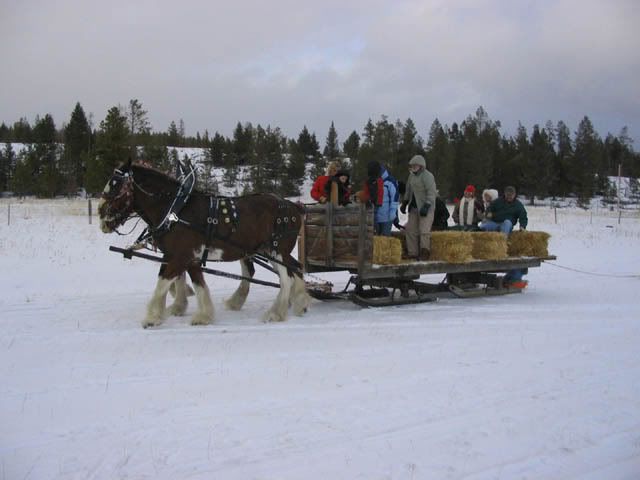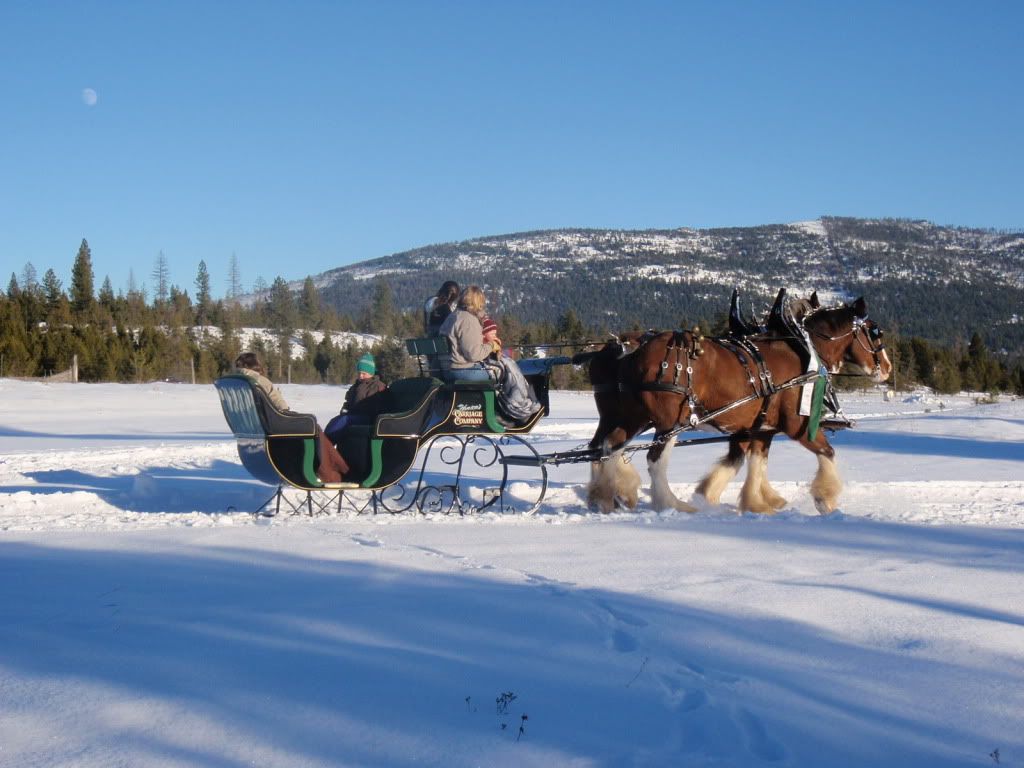Forum Replies Created
- AuthorPosts
Big Horses
ParticipantGlad to see you here Kat!!
She’s a great gal and a super talented artist! We’re lucky to have her here!
JohnBig Horses
Participant@Doc&Whisky 31295 wrote:
Doc is 16.2 hands (shod) and 2260# (he was scaled about 2 months ago by the previous owner). Whisky is 16.1 hands (shod) and I’m guessing around 2050-2100# based on comparing him to Doc.
SeanNow THAT’s a draft horse!! I always have loved them since seeing one the first time. Someday…..:rolleyes:
JohnBig Horses
ParticipantI like that idea, Rod!
There ya go, PK… simple and effective and safe!!
JohnBig Horses
ParticipantI’ve never noticed any problems with it. I hauled alot of hay alot of miles over some pretty rough ground, feeding and hauling from our haysheds and never had any problems that I thought were the sled’s fault. I’ve probably backed up a few sled-lengths at the most at one time, and it seemed to do ok. We had one hayshed that was about 7 miles away and 3 times a week, I’d head over there and throw about 50-75 bales on (depended on the condition of the road, as there was a pretty steep, long hill to pull on one end and another to go down on the other) and it would rock along, like any good sled, but never felt like it wanted to tip.
JohnBig Horses
ParticipantOur feed sled always was setup with a pole and cross chains. It sure is handy for getting into tight spots, as the front and back bobs will track when adjusted right. It’s a bit different to manuver until you get the hang of it, but that doesn’t take long.
Our sleigh that we use for rides is setup with the pole attached to the front of the runners….it’s fine, but turning tight will put a bit more side load on the pole, as you’re now trying to “skid” a full length runner sideways. I’ve had ours loaded heavy and never had an issue with that, but it is something to keep in mind.
I’ve never used one with the wheel replacement runners, but always wondered if they had a tendency to “stub their toe” and rock forward? The weight always needs to be well aft of the center of any runner to work best, but they still look like they’d need a “stay chain” or something to me.
A neighbor borrowed our feed sled one year to pattern his after, but neglected to set the “axel” back far enough on the runners. That thing pulled like a ton of bricks!! He finally changed it to match ours and it’s a whole other ballgame now! Amazing what a difference that few inches made!
John

Big Horses
ParticipantI totally agree, John. I wasn’t going to say much more, to keep from starting an argument…but I wasn’t referencing a “local” type show in my posts. Heck, our horses clean up at the local level…but we own over half of the barn here… haha There’s a “world” between the “high end” hitch horses and a horse that works…sadly. We long for the day that they both combine, but that’s not what the current trend is. Yes, they can cross over, and I’d say that what the original poster will be interested in is more along the lines of what you and I like to see as well… more of an “old style” horse. The cheaper “hitch” horses that we buy aren’t top of the line by any means according to the show people, and their price reflects that. I think for the most part, everyone here is on about the same page, just saying it a bit differently. True, a well trained horse is a well trained horse, but trained for what? A “show hitch” horse doesn’t necessarily know anything about working…but will figure it out very quickly, given the chance. I just don’t want anyone to expect a perfect working horse when it’s pulled right from the show ring. There is a bit of difference in what they already know how to do…and what they’re used to being expected to do, but most likely, they’re going to pick up what we want them to do quickly. I totally support exposing them to everything you can…we ride and drive ours, and like an old mentor of mine told me, just the fact that you spent the time to expose them to something else is going to benefit both you and the horse by strengthening that trust as well as giving that horse a more expanded “world” to draw from. It’s all good. I like them like Carl does, so that we’re not “undoing” what someone else has done… Lord knows I get enough of that. I think there has been great advice given in this thread, and it sounds like the original poster (John #1? ) is on the right track to me in all ways… I’m like the other John (#3?)… eager to see pictures and hear progress!!
John (#2? )Big Horses
ParticipantBig Horses
ParticipantVery nice Geoff!!! Santa must really like you!
JohnBig Horses
ParticipantJohn,
Go to the National Clyde sale in April, in Springfield, IL. We picked up 4 young mares a couple years ago for great prices. What you’re looking for (just like what we were looking for!) will go cheaper than the really “hitchy” horses, and will work better too! We got one mare that’s about 16.2 and a great little “old style” Clyde for practically nothing and she’s a dream to drive! The previous owner had way more money in training than we paid for the mare….plus she’s gonna (hopefully) put some good babies on the ground for us. There always seems to be plenty of people there that are headed all directions, so shipping isn’t bad.
We went there to buy a pair of geldings, and came home with 4 mares instead…. what’s wrong with that picture??? hahhaa
One thing about “hitch” horses is they’re so used to being “jacked up” and checked up, that they can be a bit goofy to work around when you first get them….that’s what the “show world” thinks is great…. usually it doesn’t take long (if you’re consistent and quiet) to get them straightened out, but like I said, you’ll have to teach them to work, as they’ve never done anything much more than trot around in a circle in an arena….
JohnBig Horses
ParticipantJohn, of course it totally depends on the horse and who’s been showing it. That being said, 99% of the “show world” has absolutely nothing to do with the real world. We have a couple that have done both, and for the most part, the transition wasn’t that big of a deal, but in alot of ways, they needed to be started over. Horses are inherently smart, and catch on quickly to what you want, if you’re consistent. One of the biggest things to watch for is leg/feet problems, as the “show world” seems to think that it’s cool to have huge, platter like, overgrown feet, and they also think everything needs to be done at a trot, so it’s all hard on the horse.
JohnBig Horses
Participant😮 Nonono…say it isn’t so!!! Actually, I can see your point John…. hate to, but I can see it. Wish we were close enough to help you with a dispersal of the Clydes! (Like WE need more!!)
JohnBig Horses
ParticipantWelcome!! Pictures are always good too!
JohnBig Horses
ParticipantBill, that’s what I figure too… I’ve been looking, but even the ones that have spreaders for “lawn art” don’t want to let any part of them go or trade any parts…go figure.
Marshall, I’ll keep my eyes open for a set…I may build some new ones…I’ll keep everyone posted.
JohnBig Horses
ParticipantSounds like a good day to me!
Big Horses
ParticipantDonn’s right on the money there. One thing to keep in mind as well, and this comes from 30 years of working on old aircraft as well as all this old farm stuff…. if you do need to heat it up, use propane. The flame isn’t as hot as oxy/acet, so you’re not as apt to do damage by overheating and having an oxygen rich flame. Cast iron’s critical point is around 1400 degrees. That being said, a great mechanical engineer friend of mine showed me that the most “active” the metal is (this varies with all metals, but is a good rule of thumb) is in the first 200 degrees of tempurature rise. If you can get it heated quickly, the shaft (or whatever) it is “stuck” on will have less temp rise, so you’re providing a bigger clearance, and therefore better chances of getting it loose.
John- AuthorPosts